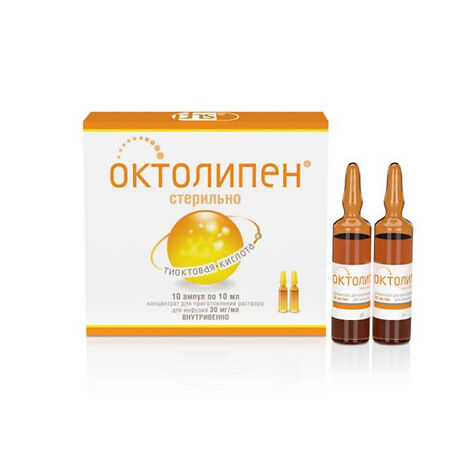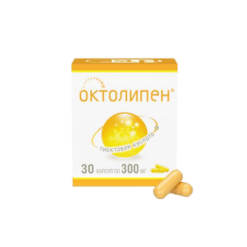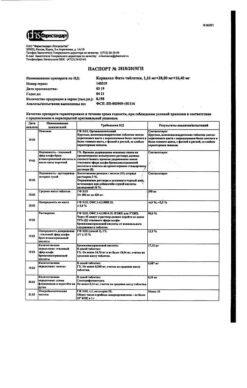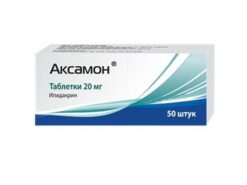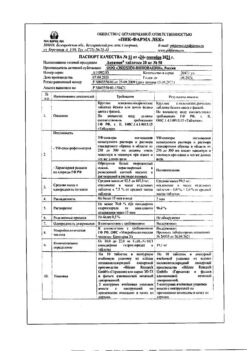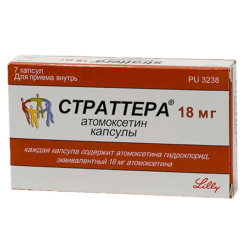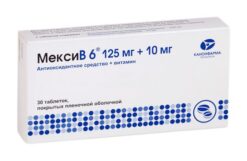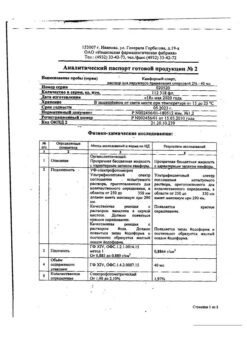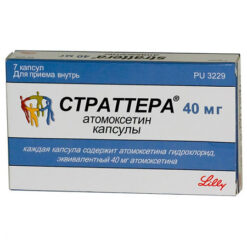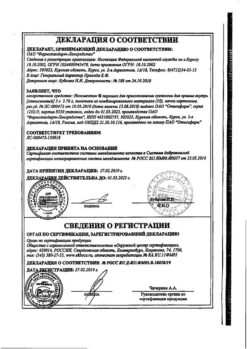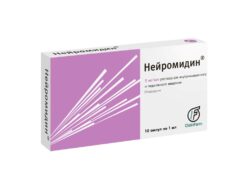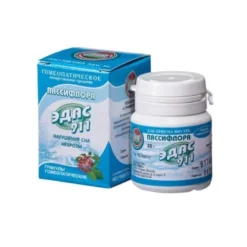No products in the cart.
Octolipen, 30 mg/ml concentrate 10 ml 10 pcs
€15.19 €13.17
Description
Pharmacotherapeutic group: metabolic agent
ATX code: A16AX01
Pharmacological properties
Pharmacodynamics
p>Thioctic acid (alpha-lipoic acid) is an endogenous antioxidant of direct (binds free radicals) and indirect action. As a coenzyme of mitochondrial multienzyme complexes is involved in oxidative decarboxylation of pyruvic acid and alpha-keto acids. It promotes reduction of blood glucose concentration and increase of glycogen content in the liver, as well as overcoming insulin resistance. By the nature of the biochemical action is close to the B vitamins. Participates in the regulation of lipid and carbohydrate metabolism, stimulates cholesterol metabolism. It has hepatoprotective, hypolipidemic, hypocholesterolemic, hypoglycemic effect. Improves trophism of neurons.
Thioctic acid in diabetes reduces the formation of glycation end products, improves endoneural blood flow and increases glutathione content to physiological levels that as a result improves the functional state of peripheral nerve fibers in diabetic polyneuropathy. Due to its involvement in fat metabolism, thioctic acid increases the biosynthesis of phospholipids, particularly phosphoinositides, restoring damage to cell membranes; it normalizes energy metabolism and nerve impulse conduction. Thioctic acid eliminates the toxic effects of alcohol metabolites (acetaldehyde, pyruvic acid), reduces endoneural hypoxia and ischemia, weakening manifestations of polyneuropathy in the form of paresthesia, burning sensation, pain and numbness of the extremities.
Thioctic acid thus has antioxidant, neurotrophic effects and improves lipid metabolism.
Pharmacokinetics
Absorption and distribution. When thioctic acid is administered intravenously at a dose of 600 mg, the maximum plasma concentration after 30 minutes is approximately 20 µg/mL. The area under the curve “concentration-time” is about 5 µg/h/ml. Bioavailability is 30%. The volume of distribution is about 450 ml/kg.
Metabolism and excretion. Thioctic acid (alpha-lipoic acid) has a “first pass” effect through the liver. Metabolites are formed by oxidation of the side chain and conjugation. Thioctic acid and its metabolites are excreted by the kidneys mainly as metabolites (80-90%), in small amounts unchanged. The elimination half-life is about 25 min. Total plasma clearance is 10-15 ml/min.
.
Indications
Indications
diabetic polyneuropathy;
alcoholic polyneuropathy.
Pharmacological effect
Pharmacological effect
Pharmacotherapeutic group: metabolic agent
ATC code: A16AX01
Pharmacological properties
Pharmacodynamics
Thioctic acid (alpha-lipoic acid) is an endogenous antioxidant of direct (binds free radicals) and indirect action. As a coenzyme of mitochondrial multienzyme complexes, it participates in the oxidative decarboxylation of pyruvic acid and alpha-keto acids. Helps reduce blood glucose concentrations and increase glycogen content in the liver, as well as overcome insulin resistance. By the nature of its biochemical action it is close to B vitamins. Participates in the regulation of lipid and carbohydrate metabolism, stimulates cholesterol metabolism. It has hepatoprotective, hypolipidemic, hypocholesterolemic, hypoglycemic effects. Improves trophism of neurons.
In diabetes mellitus, thioctic acid reduces the formation of advanced glycation end products, improves endoneurial blood flow, increases glutathione content to a physiological level, which ultimately leads to an improvement in the functional state of peripheral nerve fibers in diabetic polyneuropathy. Due to its participation in fat metabolism, thioctic acid increases the biosynthesis of phospholipids, in particular phosphoinositides, restoring damage to cell membranes; normalizes energy metabolism and the conduction of nerve impulses. Thioctic acid eliminates the toxic effects of alcohol metabolites (acetaldehyde, pyruvic acid), reduces endoneurial hypoxia and ischemia, weakening the manifestations of polyneuropathy in the form of paresthesia, burning sensation, pain and numbness of the extremities.
Thus, thioctic acid has an antioxidant, neurotrophic effect, and improves lipid metabolism.
Pharmacokinetics
Absorption and distribution. With intravenous administration of thioctic acid at a dose of 600 mg, the maximum concentration in blood plasma after 30 minutes is about 20 mcg/ml. The area under the concentration-time curve is about 5 mcg/h/ml. Bioavailability 30%. Volume of distribution – about 450 ml/kg.
Metabolism and excretion. Thioctic (alpha-lipoic) acid has a “first pass” effect through the liver. The formation of metabolites occurs as a result of side chain oxidation and conjugation. Thioctic acid and its metabolites are excreted by the kidneys mainly in the form of metabolites (80-90%), in small quantities unchanged. The half-life is approximately 25 minutes. Total plasma clearance – 10-15 ml/min.
Special instructions
Special instructions
In patients with diabetes mellitus, especially at the beginning of treatment, constant monitoring of plasma glucose concentration is necessary. In some cases, it may be necessary to reduce the dose of hypoglycemic agents. If symptoms of hypoglycemia occur (dizziness, increased sweating, headache, blurred vision, nausea), you should immediately stop administering the drug.
When administered parenterally, hypersensitivity reactions may occur. If symptoms such as itching or malaise appear, you should immediately stop administering the drug.
During treatment, and also, if possible, in between courses, it is necessary to refrain from drinking alcohol, since the therapeutic effect of thioctic acid is weakened by exposure to alcohol, and is also a risk factor for the development and progression of neuropathy.
The drug is photosensitive, so the prepared solution of the drug should be protected from exposure to light.
Several cases of the development of autoimmune insulin syndrome in patients with diabetes mellitus while taking thioctic acid, which was characterized by frequent hypoglycemia in the presence of autoantibodies to insulin, have been described. The possibility of the occurrence of autoimmune insulin syndrome is determined by the presence of haplotypes HLA-DRB1*0406 and HLA-DRB1*0403 in patients.
Influence on the ability to drive vehicles and machinery
The effect on the ability to drive vehicles and other mechanisms has not been specifically studied, therefore, during treatment with Octolipen®, it is recommended to be careful when driving vehicles and other mechanisms and engaging in other potentially hazardous activities that require increased concentration and speed of psychomotor reactions.
Active ingredient
Active ingredient
Thioctic acid
Composition
Composition
Active ingredient: thioctic acid (α-lipoic acid) – 300 mg;
Excipients: ethylenediamine – 87.4 mg; disodium edetate (disodium salt of ethylenediaminetetraacetic acid) – 1 mg; water for injection – up to 10 ml.
Pregnancy
Pregnancy
Due to the lack of sufficient clinical experience with the use of thioctic acid during pregnancy and breastfeeding, the use of the drug in the corresponding category of patients is contraindicated.
Contraindications
Contraindications
hypersensitivity to thioctic acid and/or any excipient of the drug;
age under 18 years (efficacy and safety of use have not been established);
pregnancy and breastfeeding (there is no sufficient experience in using the drug).
With caution
Intravenous administration of the drug should be carried out with caution in elderly patients (over 75 years of age).
Side Effects
Side Effects
According to the World Health Organization (WHO), adverse reactions are classified according to their frequency of development as follows: often (≥ 1/100, < 1/10), uncommon (≥ 1/1000, < 1/100), rare (≥ 1/10000, < 1/1000) and very rare (< 1/10000); frequency unknown (the frequency of events cannot be determined from the available data). There is no correlation between the incidence of adverse reactions and the gender or age of patients.
Blood and lymphatic system disorders:
very rarely: petechial hemorrhages in the mucous membranes, skin; hemorrhagic rash (purpura), thrombocytopathy, hypocoagulation.
Immune system disorders:
very rare: allergic reactions (skin rash, eczema, urticaria, itching);
frequency unknown – anaphylactic shock; autoimmune insulin syndrome in patients with diabetes mellitus, which is characterized by frequent hypoglycemia in the presence of autoantibodies to insulin.
Metabolic and nutritional disorders:
very rare: hypoglycemia (due to improved glucose utilization), symptoms of which include dizziness, increased sweating, headache, blurred vision.
Nervous system disorders:
very rare: change or disturbance in taste sensations, hot flashes, convulsions.
Gastrointestinal tract disorders:
often: nausea, vomiting;
very rare: abdominal pain, diarrhea.
Disorders of the liver and biliary tract:
very rare: increased activity of liver enzymes.
Heart disorders:
frequency unknown: with rapid administration of the drug, pain in the heart area and tachycardia are possible.
Vascular disorders:
very rarely – thrombophlebitis.
Vision disorders:
very rare: diplopia, blurred vision.
General disorders and disorders at the site of care:
very rarely: weakness, burning sensation at the injection site;
frequency unknown: allergic reactions at the injection site – irritation, redness or swelling.
Others:
very rare: with rapid intravenous administration, a spontaneous increase in intracranial pressure (a feeling of heaviness in the head), difficulty breathing, weakness is possible.
Interaction
Interaction
Thioctic acid is capable of forming chelate complexes, so co-administration with iron, magnesium, and calcium preparations should be avoided.
Thioctic acid (in the form of a solution for infusion) leads to a decrease in the effectiveness of cisplatin when used simultaneously.
Thioctic acid forms poorly soluble complex compounds with sugar molecules, therefore, it is incompatible with dextrose (glucose), fructose, Ringer’s solution, as well as with solutions that interact with disulfide and SH groups.
When used simultaneously with insulin and oral hypoglycemic agents, an increase in the hypoglycemic effect is observed.
Thioctic acid enhances the anti-inflammatory effect of glucocorticosteroids.
Ethanol and its metabolites reduce the therapeutic effectiveness of thioctic acid.
Overdose
Overdose
Symptoms: headache, nausea, vomiting.
In severe cases (when taking thioctic acid in a dose of 10-40 g): psychomotor agitation or clouding of consciousness, generalized convulsions, severe acid-base balance disorders, lactic acidosis, hypoglycemia (up to the development of coma), acute necrosis of skeletal muscles, disseminated intravascular coagulation syndrome (DIC syndrome), hemolysis, suppression of bone function brain, multiple organ failure.
Treatment: If a significant overdose of thioctic acid is suspected, emergency hospitalization and immediate application of measures in accordance with the general principles adopted for accidental poisoning are recommended. Therapy is symptomatic. Treatment of generalized seizures, lactic acidosis and other life-threatening consequences of overdose should be in accordance with the principles of modern intensive care. There is no specific antidote. Hemodialysis, hemoperfusion or hemofiltration methods for the forced elimination of thioctic acid are not effective.
Storage conditions
Storage conditions
In a place protected from light at a temperature not exceeding 25 °C.
Keep out of the reach of children.
Shelf life
Shelf life
2 years.
Do not use after the expiration date stated on the package.
Manufacturer
Manufacturer
Pharmstandard-UfaVITA, Russia
Additional information
| Shelf life | 2 years. Do not use after the expiration date stated on the package. |
|---|---|
| Conditions of storage | Store in a light-protected place at a temperature not exceeding 25 °С. Keep out of reach of children. |
| Manufacturer | Pharmstandard-UfaVITA, Russia |
| Medication form | concentrate for preparation of infusion solution |
| Brand | Pharmstandard-UfaVITA |
Other forms…
Related products
Buy Octolipen, 30 mg/ml concentrate 10 ml 10 pcs with delivery to USA, UK, Europe and over 120 other countries.

